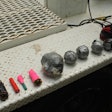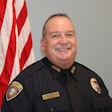The history of a powerful prison gang.
In the mid-1950s 13 California Youth Authority (CYA) wards were sent to the Duel Vocational Institute located in Tracy, California. Since the wards were juveniles they were housed in a special section of the adult corrections facility.
These wards were violent and had defiant attitudes. Together between 1956 and 1957 they formed the "Gang of Gangs," commonly known as the Mexican Mafia or La Eme, (see "In the Hood," Feb. 2000).
Developed by a gang member from Hawaiian Gardens, the nucleus of the gang got its members from Florencia 13, EI Hoyo Maravilla, Primera Flats, Geraghty Loma gangs and other L.A. County Mexican street gangs. Ironically, all the original members were U.S. citizens, not Mexican nationals. All primarily spoke English and Calo, only a few spoke Spanish.
This cadre of street-toughened gang members created the rules of conduct for new members. One of the rules of membership required that a perspective member be sponsored by bonafide Mexican Mafia members. In addition, by the early I970s a new member was also asked to take a blood oath for life. This was done to confirm complete unquestioned allegiance to the gang. The oath required that a member do whatever the gang asked, without question or comment. This membership was for life and it was more important than your family. Any violation of this oath was punished with death. Because of this philosophy the gang's rally cry became, "Blood in, Blood out."
The original group of gang members was eventually transferred to San Quentin because of behavior problems.
The 1960's
By the early 1960s the Mexican Mafia had gained such a reputation that many street gang members aspired to join the gang. The gang's membership grew rapidly and its influence spread throughout the street and prison system.
By 1966, the 18th Street had formed in Los Angeles. This is unique because it became the first Mexican street gang to break the race barrier for membership. The race membership barrier was broken by 18th Street and the Mexican Mafia for different reasons. The Mexican Mafia chose and still chooses its members based on their practice of the Mexican gang culture. This allowed growth for the Mexican Mafia to be based on "quality." The 18th Street gang just allowed anyone in, in essence the gang admitted people who could not qualify for membership in other Mexican street gangs.
This allowed 18th Street to grow quickly, but the growth was based on "quantity." More importantly, as 18th Street established itself in the drug market, the Mexican Mafia took notice almost immediately. The Mexican Mafia put pressure on civilian 18th Street cliques to conform to more traditional Mexican street gang culture and weed out the non-Hispanic members.
By this time an informal rivalry developed between Mexicans from Northern California and those from Southern California, despite the efforts of one Eme member named Rudy "Cheyenne" Cadena, who was trying to unite all Mexican inmates.
As detailed in the February 2000 article, a stolen pair of shoes, a gift, an insult to an Eme gang member and subsequent death of a Mexican inmate from the North prompted formal negotiations to stop. (It should be noted that there is more than one version of this story.)
This north-south split also caused street rivalries between gangs to be set aside while in prison. The split acted as a bonding agent for Mexican gang members while incarcerated because now they had a common enemy. By the late 1960s, a gang ethic had been formed and there were certain rules that bad to be followed. A standard gang practice and custom had been developed.
The 1970's
In 1970, the now well-known Mexican Mafia member, Joe "Pegleg" Morgan was recruited into the gang. Morgan was highly respected and feared in and out of the correction system. Though he was a member of a Mexican street gang, he was of Slavic decent. Morgan however, spoke, read and wrote Spanish fluently. Raised in Los Angeles, he took pride in the Mexican heritage. He earned the reputation of being a violent, ruthless and cunning inmate through his association with the Maravilla street gang. According to Sgt. Richard Valdemar, Morgan had also established strong ties to other L.A.-based street gangs, the Italian Mafia and with the drug traffickers from Mexico.
By 1972, Morgan had become the figurehead leader of La Erne. Also by this year, Morgan had solidified the alignment between the Mexican Mafia and the Aryan Brotherhood. This was done in order to strengthen the Erne power base, because the Black Gueril1a Family had also formed. La Erne was preparing for a war.
La Eme flourished in the 1970s when it started to exert its influence on the streets. Mexican Mafia parolees were held with a high degree of respect by street gang members. These parolees would routinely Ca1TY out Erne assigned hits. Between 1976 and 1977 there were more than 30 Erne executions on the streets. One victim was a California State Senator's aid, who was assassinated in Los Angeles.
By 1975, La Eme started to infiltrate federally funded community organizations. One such organization was Project Get Going. The grant writer for the project was murdered while traveling to Sacramento to testify against La Erne. The project director was the grant writer's husband and also member of the Mexican Mafia.
The common enemies of La Erne were the remaining two prison gangs, the Black Guerilla Family (BGF) and Nuestra Familia (NF). The BGF and NF also made a pact that aligned themselves against the Aryan Brotherhood and La Eme.
La Eme prepared for the battles by purging its own ranks of members who were weak or not following the rules. Mexican Mafia members would shave their heads when they went to war. The shaved head became a silent signal to other Mexican Mafia prison gang members and inmates of an on coming attack
In the late 1970s the Mexican Mafia influence was curtailed because a couple of members became police informants. The cooperating prison gang members helped initiate major criminal investigations against the prison gang. In May 1978, Morgan was sent to federal prison for five years. This did not stop the Mexican Mafia or its influence, it just brought it into the Federal corrections system.
The 1980's
Even though major criminal investigations had been started, Eme members continued their illegal activities. The Prison gang expanded its control in heroin trafficking, gambling, debt collection, extortion, prostitution and other illegal inmate activity into the community.
By this time La Erne had established control of the Hispanic inmate population in Southern California. It also exerted a great degree of control over the Hispanic drug dealers operating in Los Angeles County.
The late 1980s brought further changes for the Mexican Mafia. The gang started to consolidate its power base. It also appeared that the north-south dividing line had been moved north to the city of San Jose. In 1987, Morgan's influence was so great that he helped establish the so-called "Folsom Truce" between the Mexican Mafia and the Black Guerilla Family. As it turns out, it is really a set of battle rules to help avoid detection by the prison staff.
The 1990's
The Mexican Mafia exerted a strong influence and control over Southern California Hispanic street gangs in the early 1 990s. Between 1992 and 1993 La Eme orchestrated a series of mandatory meetings for the street gangs. The meetings were used to notify the street of the "Eme Edict." Basically, this was an order by the prison gang issued to the street gangs to stop all the drive-by shootings and end the violence.
Publicity-wise, the general media jumped on the wagon. The word that a prison gang was trying to stop the street gang violence quickly spread. What was not commonly known at the time was that there were additional non-public directives. Hispanic street gangs were also required to pay "tax." The tribute was allegedly going to be paid for Mexican Mafia protection. The Eme influence was so great that drive-by shootings stopped in an area of East L.A. between April and September 1993. It was dictated that walkup style shootings were to be used instead.
Non-tax-paying gangs and disobedient gang members were placed on a "green light" list. This gave compliant street gangs permission to kill the non-compliant gang members with the blessing of the prison gang.
In November, 1993 Morgan died of liver cancer while in prison. Morgan's style of leadership established the Mexican Mafia as one of the most influential Prison gangs in the country.
By late 1999, the Mexican Mafia had suffered through two Federal RICO prosecutions in California and one in Texas. The leadership structure was essentially dismantled. Gang operations were temporarily slowed. La Eme is still collecting taxes, but has had to endure many embarrassing events, such as Erne impersonators collecting the tax money and stealing it, shooting up wrong houses in assassination attempts and having Erne parolees shot at and chased out of neighborhoods. There is also a fair amount of infighting between Mexican Mafia cliques.
The Mexican Mafia can be found in 13 states, so it has national status. La Eme parolees have also been contacted in Mexico. This makes the Mexican Mafia the largest prison gang in the United States.
La Eme membership is estimated to be between 300-1000 members and associates. When experts are asked just how many murders has the prison gang been responsible for in its 43-year history, the number of 1000 plus is frequently given.
Be safe!
A special thanks to Sgt. Richard Valdemar, prison Gang Expert, Los Angeles County Sheriff's Department for his assistance with this article.













